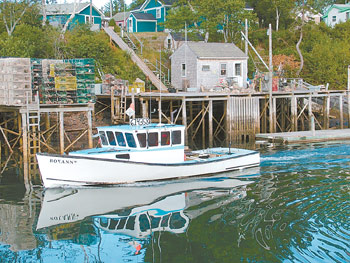Shell Game
Lobster Industry Makeover
by Laurie Schreiber
|
Fishermen told the Governor’s Task Force on the Economic Sustainability of Maine’s Lobster Industry that the decline of lobster prices impacts not only the people who go out on the water to harvest the product, but the entire state community and economy that depends on the product.
The task force held a meeting recently in Ellsworth to get public input following their meeting in Portland. The panel was charged with reporting to the governor and the legislature by April 15.
“Last fall, dealers said, ‘Please don’t stop fishing, we’ve got markets to supply’,” said Jon Carter of Bar Harbor.
Last fall’s precipitous decline in prices was enough to make much of the fleet go on strike for a few days. It also induced considerable mistrust from fishermen, who said they were getting paid far less for their product and failed to receive the benefit of mark-ups that occurred along the chain of supply once the lobsters left their hands.
“We all feel we’re being taken advantage of,” Carter said.
“It’s nice to be able to go to work in the morning, work hard, and be rewarded at the end of the day,” said Nick Lemieux of Cutler.
Lemieux said he was selling lobsters at $2.40 to $2.70 per pound.
But dealers, retailers and restaurants were getting paid far more, he said.
“We’re at the bottom of this,” he said.
continue
|

Bunker’s Harbor, Gouldsboro, Maine. The latest price drop for lobster has illuminated the many ways the lobster industry has changed in recent decades. Some in the industry are trying to find ways of adjusting to that change that will give lobstermen more secure economic footing. Others are looking at developing the industry’s markets as a means of meeting the change. Greater profit share equity is on the minds of most lobstermen. Fishermen’s Voice photo |
|
Maine Steamers
by Mike Crowe
|
All but forgotten today, the steamer was a common means of transportation along the Maine coast for over a century. Steamers brought passengers and freight up the shallow rivers to the farm land, mill towns where most people were settling in the early 1800s. The bigger boats on the longer runs to Portland and Boston gained greater fame, but the many boats on runs between river, coastal and island towns made them a part of everyday life. For some towns the arrival of the steamboat was an event to witness in the days before the automobile, train or even roads smooth enough to drag a wagon over. They hauled freight, cargo and brought some of the first tourists to Maine.
Steamboat technology, popularity and scale developed rapidly. The demand was driven by their being able to sail without waiting for wind or tides at predictable speeds, as well as access to shallow water ports. While their use overlapped the automobile and the airliner, they were developed as early as the second term of George Washington. At least one early steam engine had a wooden boiler with metal bands around it. This simple design gives a perspective to the tech-nology and the wooden econ-omy in which it developed. It also helps explain why explosions were the single most common cause of the loss of steamboats, but by no means the only cause.
continue
|
| The City of Bangor struck on Monhegan Island in thick fog on September 28, 1902 and was run onto Lobster Beach to prevent sinking. Launched in 1894, she steamed the Penobscot River becoming one of the legends of the steamboat era. Photo: Deer Isle - Stonington Historical Society |
|
|

